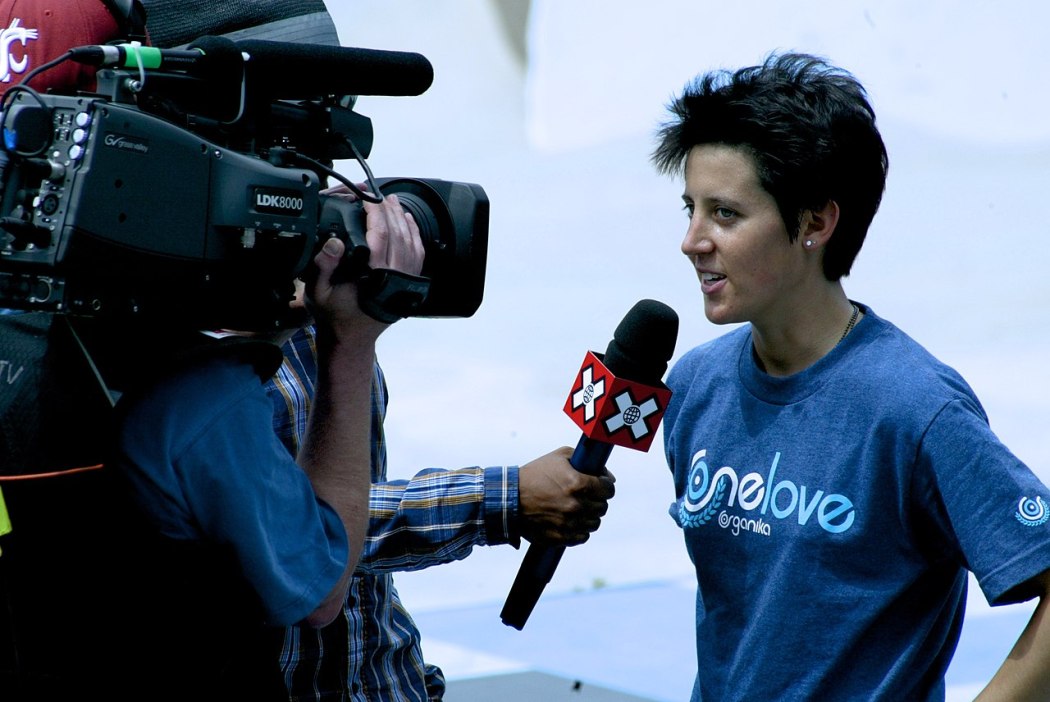By Paul O’Connor
There is much in Tim Hamlett’s opinion piece on Olympic skateboarding that had me nodding vigorously in agreement. Yes, the International Olympic Committee is a secretive and dishonest group that promotes the Olympics as little more than a lucrative mass media spectacle. Yes, it is also an unpleasant promoter of sadly-not-outdated-enough inward-looking nationalism.
Yet his reading on skateboarding’s debut at the games conforms to a sort of standardised thinking that the Olympic model cultivates.

Perhaps the most important issue to address is that of the young medal winners in the women’s skateboarding event. Thirteen-year-old skaters Momiji Nishiya and Rayssa Leal took gold and silver respectively, and 16-year-old Funa Nakayama won bronze. Over the last few days, I have been hearing an echo chamber of reactions. “Why are they all so young?” “It’s a sport for teens.”
See also: Awesome skill and courage – but the Olympics set a poor example for young skateboarders
Firstly, let us address the fact that fourth place went to a 34-year-old, Alexis Sablone. She narrowly missed out on a podium placing but also has a long history in skateboarding, appearing in an iconic and influential video (PJ Ladd’s Wonderful Horrible Life) in her early teens.
Sablone is also a graduate of MIT and an architect with a skateable piece of public art installed in the Swedish city of Malmö. She carved out a career in skateboarding when few other women were given a platform, endorsements, or serious recognition from the skateboard industry. She is representative of an old guard who did not benefit from large multinational endorsements, national sports funding and physical therapy. The presence of very young women in skateboarding contests is partly a circumstantial blip in the recent popularity of the sport.

Over the last decade skateboarding has seen a huge boom in popularity amongst young women. Social media has been rocket fuel to this development, allowing women skateboarders to circumvent the gendered barriers in the sport’s traditional media.
Importantly, the Olympics has also opened the door to women skateboarders ever since the sport was announced as a new event in 2016. These young competitors are not disappearing, they will likely have long and enduring careers in skateboarding, and – like Sablone – might be competing well into their thirties. In short, these young women have grown up with the possibility of skateboarding being very much an option and reality for them.
The other dominant issue discussed in response to the Street Skateboarding event was an absence of safety gear. The first thing to flag here is the double standard that we see in discussing skateboarding aside from other sports. The dangers of gymnastics, high diving, basketball and other sports are often dismissed.
In truth, much of skateboarding can be similarly as dangerous but – for the majority of participants – much much less so. Olympic rules state that those under 18 must wear a helmet while those over 18 have a choice. So, while various commentators argue that there is a moral responsibility for Olympic athletes to dress safely, to set an example, do also remember that skateboarding is not simply a sport but also a culture and lifestyle. It has ethics and values that people are deeply committed to.
My own recent research explores the way in which skateboarding operates as religious discipline in many peoples’ lives. One of the most important aspects of skateboarding is participant control – the need for skateboarders to dictate the way it is included and represented. The IOC has taken this seriously, simply because the IOC needs skateboarding more than skateboarding needs the IOC. Also remember that skateboarding spectators are a relatively new phenomenon. Most people who watch and consume skateboarding also take part themselves and thus have some comprehension of the physicality and limits of what they are watching.
Seminal work on skateboarding by Iain Borden, a professor of architectural history, highlights the fact that skateboarding enacts a critique of rules and regulation. Street skateboarding demonstrates a way to rethink the city, to make it playful and enjoyable rather than a constrained vehicle of commerce. It is clearly dangerous to throw yourself down a handrail on a skateboard. After all, a handrail is a device built for safety not for danger.
But to think that even attempting this is an easy feat is to totally misunderstand skateboarding. A novice will barely be able to move competently, let alone jump on a board. Thus, the innate difficulty of skateboarding helps to check a lot of really stupid behaviour. Sadly, we can’t say the same for a whole host of other very accessible and legal activities. So those orthopaedic comments are rather glib. People, especially young people, have long been aware of what skateboarding is. It is the older generation which needs to understand skateboarding beyond its stereotypes of broken bones and delinquent teens.
In risk-averse Hong Kong where all playgrounds are designed for maximum safety and minimum joy, skateparks offer a rejoinder to the stifling notion that the world can be predictably controlled. We hear far too much of panic-stricken youth, crippled by social anxiety, chained to screens and lacking in social contact. Skateboarding is an antidote to those things and to many other ills of the modern world. Yes, it is rough round the edges, dangerous at times, and involves a lot more failure than success. It is a lot like real life. Yet, it also isn’t innately competitive. Watch the skateboarding athletes, the way they interact with each other. Yes, the way competitors celebrate each other.
A case in point is Filipina skateboarder Margielyn Didal who placed seventh in the Olympic Street Skateboarding competition. Her joyful friendship with Brazilian Rayssa Leal and her infectious enthusiasm has won her thousands of adoring fans. Margie is not only a success for the Philippines, she is also a success for Hong Kong, being sponsored by the iconic local store 8Five2. Owner Brian Siswojo spotted her innate flair and talent back when she was 16. She competed on her signature skateboard designed and sold by 8Five2, again underlying the way in which skateboarders and their sponsors are not national products.
Many local skateboarders in the territory have skated with Margie and know her personally. She even took part in an event showcasing skateboarding at Lingnan University. Margie grew up skating in the streets of Cebu and won gold in the Asian Games in 2018. What she is excitingly representative of, and what the Olympics also showcases even though people are not discussing it enough, is the powerful presence of Asian women as high-performing skateboarding athletes. This unpicks the narrative of the typical skateboarder as a blonde Californian dude.
Skateboarders have been rightly anxious that the Olympics will tarnish their sport and the niche world they have created. At the same time, they are incredibly proud that people can get a glimpse of their achievements, recognise the fraternity and joy of the sport, and understand that it isn’t simply about scoring points.
Paul O’Connor is a lecturer in Sociology and Anthropology at the University of Exeter, and Adjunct Assistant Professor at Lingnan University. He is author of the book Skateboarding and Religion, and has published various research on helmet use in skateboarding, Chinese women skateboarders, Skateboarding in Hong Kong, and skateparks.
Support HKFP | Policies & Ethics | Error/typo? | Contact Us | Newsletter | Transparency & Annual Report | Apps
| HKFP is an impartial platform & does not necessarily share the views of opinion writers or advertisers. HKFP presents a diversity of views & regularly invites figures across the political spectrum to write for us. Press freedom is guaranteed under the Basic Law, security law, Bill of Rights and Chinese constitution. Opinion pieces aim to point out errors or defects in the government, law or policies, or aim to suggest ideas or alterations via legal means without an intention of hatred, discontent or hostility against the authorities or other communities. |
Help safeguard press freedom & keep HKFP free for all readers by supporting our team

More HKFP OPINION:
HKFP has an impartial stance, transparent funding, and balanced coverage guided by an Ethics Code and Corrections Policy.
Support press freedom & help us surpass 1,000 monthly Patrons: 100% independent, governed by an ethics code & not-for-profit.











